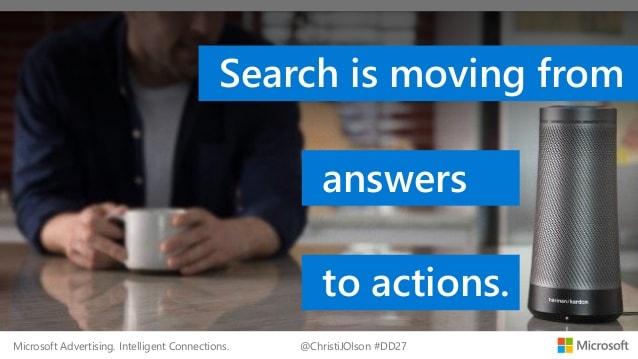Table of contents:
- 2019 voice-assistant statistics
- 8 reasons why people use voice-assistants
- 2019 Microsoft Voice Report key insights
- 3 brands using Alexa skills to grow
- How to optimize your content for voice search
Voice is changing customer behaviour and the way we do marketing.
These changes have brought about the advent of vCommerce (voice commerce). vCommerce is the next stage of eCommerce designed to include voice shopping.
In this article, I share statistics, insights and recommendations curated from Think with Google, eMarketer and Microsoft to help you get an overall view of voice commerce and the factors underpinning its growth.
People like talking; it’s our main way of exchanging information, connecting with each other and doing things. The latest developments in machine learning allowed for the rapid growth of voice-control technology like voice assistants (Google Duplex, Alexa etc) and voice search.
Why are voice-assistants so popular?
Because they make our life easier.
When you’re preparing a new recipe for your family, it’s more convenient to get step-by-step guidance by voice than to fumble on your smartphone with your hands dirty of flour, oil or minced meat.
According to eMarketer, voice-control technology has officially moved out of the early-adopter phase and into the mainstream.
The market is expanding quickly. Is your marketing ready for it?

2019 Voice-Assistants Statistics
![]() By 2021, the number of US voice assistant users will reach 122.7 million, representing 42.2% of US internet users and 36.6% of the US population (eMarketer)
By 2021, the number of US voice assistant users will reach 122.7 million, representing 42.2% of US internet users and 36.6% of the US population (eMarketer)
![]() There will be 57.6 million female and 54.2 million male voice assistant users in the US by the end of 2019 (eMarketer)
There will be 57.6 million female and 54.2 million male voice assistant users in the US by the end of 2019 (eMarketer)
![]() 62% of those who regularly use a voice-activated speaker say they are likely to buy something through their voice-activated speaker in the next month (ThinkWithGoogle)
62% of those who regularly use a voice-activated speaker say they are likely to buy something through their voice-activated speaker in the next month (ThinkWithGoogle)
![]() 44% of those who regularly use a voice-activated speaker say they order products they need like groceries, household items, etc., at least once a week (ThinkWithGoogle)
44% of those who regularly use a voice-activated speaker say they order products they need like groceries, household items, etc., at least once a week (ThinkWithGoogle)
![]() 53% of people who own a voice-activated speaker said it feels natural talking to it (ThinkWithGoogle)
53% of people who own a voice-activated speaker said it feels natural talking to it (ThinkWithGoogle)
![]() 51% of people 55+ said a top reason for using voice-activated speakers is “it empowers me to instantly get answers and information” (ThinkWithGoogle)
51% of people 55+ said a top reason for using voice-activated speakers is “it empowers me to instantly get answers and information” (ThinkWithGoogle)
![]() 72% of parents who own voice-activated speakers said they are likely to use them to buy something in the next month, compared to 51% of non-parents (ThinkWithGoogle)
72% of parents who own voice-activated speakers said they are likely to use them to buy something in the next month, compared to 51% of non-parents (ThinkWithGoogle)
![]() Almost 70% of requests to the Google Assistant are expressed in natural language, not the typical keywords people type in a web search (ThinkWithGoogle)
Almost 70% of requests to the Google Assistant are expressed in natural language, not the typical keywords people type in a web search (ThinkWithGoogle)
![]() 80% of users reported being somewhat or very satisfied (2019 Microsoft Voice Report)
80% of users reported being somewhat or very satisfied (2019 Microsoft Voice Report)
![]() 66% of owners use them weekly (2019 Microsoft Voice Report)
66% of owners use them weekly (2019 Microsoft Voice Report)
Why are people using voice-assistants? 8 reasons according to Think with Google
- It allows them to more easily multitask.
- It enables them to do things faster than other devices.
- It empowers them to instantly get answers and information.
- It makes their daily routine easier.
- It’s in the centre of the home.
- People are getting more done with less friction.
- It offers a new, more human relationship with technology. People are engaging with their voice-activated speakers as if they were human.
- Parents are power users and shoppers. Being a parent is a full-time job, they literally have their hands full most of the time every day. So it’s easier to get other things done by talking to a voice-assistant. Parents want to find business information, call up customer service, and discover new brands using their devices. Voice-assistants are also a way to keep the kids entertained and help parents catch a break and relax for a few minutes.
2019 Microsoft Voice Report Key Insights
What started out as blue links on a search engine results page (SERP) is currently transforming into something even larger in scale and deeper in breadth. The blue links are disappearing. Keywords are disappearing. Keyboards are disappearing. What will be left?
Microsoft Voice Report 2019
Microsoft’s 2019 Voice Report analyzes the latest voice disruption.
Here are the report’s most interesting findings related to voice and voice search:
![]() Search moves from a place of answers to a state of action. Consumers are using voice search to shop, get directions, make reservations, book travel, etc.
Search moves from a place of answers to a state of action. Consumers are using voice search to shop, get directions, make reservations, book travel, etc.
![]() Voice itself is not the next big disruptor. Conversational AI has a bigger impact on consumer behaviour because it flips the user dynamic: instead of humans learning computer code, computers are learning our language.
Voice itself is not the next big disruptor. Conversational AI has a bigger impact on consumer behaviour because it flips the user dynamic: instead of humans learning computer code, computers are learning our language.
![]() Search engines are morphing into personal digital assistants.
Search engines are morphing into personal digital assistants.
![]() Even though smartphones currently outnumber smart speakers, this could also change fast as smart speakers head mainstream. Consumers find themselves putting down their phones to engage more with their smart speaker.
Even though smartphones currently outnumber smart speakers, this could also change fast as smart speakers head mainstream. Consumers find themselves putting down their phones to engage more with their smart speaker.
![]() Voice-controlled technology has crossed the chasm from early adopters into the early majority of users.
Voice-controlled technology has crossed the chasm from early adopters into the early majority of users.
![]() Voice is a replacement for keyboards and touchscreens.
Voice is a replacement for keyboards and touchscreens.
![]() vCommerce (voice commerce) is the next stage of eCommerce designed to include voice shopping. It minimizes friction, elevates ease and convenience to a new level in which there will be no going back. Why waste time by standing in line to order your custom coffee when you could tell Alexa to have it ready for in-store pickup?
vCommerce (voice commerce) is the next stage of eCommerce designed to include voice shopping. It minimizes friction, elevates ease and convenience to a new level in which there will be no going back. Why waste time by standing in line to order your custom coffee when you could tell Alexa to have it ready for in-store pickup?
![]() 35% of respondents have made a purchase using voice and they enjoyed the experience.
35% of respondents have made a purchase using voice and they enjoyed the experience.
![]() 70% believe that the digital assistants will not only help them shop but understand their preferences and make routine purchases on their behalf within 5 years.
70% believe that the digital assistants will not only help them shop but understand their preferences and make routine purchases on their behalf within 5 years.
![]() Brands will need to pay attention to how each of the digital assistants and voice technologies pull their recommendations to make sure that they don’t get left behind.
Brands will need to pay attention to how each of the digital assistants and voice technologies pull their recommendations to make sure that they don’t get left behind.
![]() vCommerce redefines shopping, repurposes the functions of a physical store, minimizes time and stress for consumers and maximizes the importance of personalization and brand loyalty.
vCommerce redefines shopping, repurposes the functions of a physical store, minimizes time and stress for consumers and maximizes the importance of personalization and brand loyalty.
![]() Retailers should create digital assistants that don’t just sell products but act as trusted resources.
Retailers should create digital assistants that don’t just sell products but act as trusted resources.
![]() Retailers should not approach voice skills and actions as shiny new things, but try to solve actual problems to create deeper relationships with their customers.
Retailers should not approach voice skills and actions as shiny new things, but try to solve actual problems to create deeper relationships with their customers.

3 brands using Alexa skills to grow
Campbell’s Kitchen skill provides users with recipes that incorporate ingredients they already have in their kitchen.
Zyrtec’s Your Daily Allergy Cast skill blends information from the local weather forecast, the pollen count and a database of the most common outdoor allergens to predict the impact on the user’s allergies.
Tide’s Stain Remover skill can help users remove just about anything from their clothing.
Curious how other brands use Alexa skills? Read These 13 brands use Alexa Skills to engage creatively with their consumers.
How to optimize your content for voice search
Write content that is both informational (“What is the best brand of paper towel?”) and action-based (“Order more paper towels.”)(Think with Google)
Write content with natural language. Voice searches are longer and more conversational than text-based search. (Think with Google)
Include filler words in question keywords – I, the, me, for. Mobile searches for “do I need” have grown over 65%. For example, “how much do I need to retire,” “what size generator do I need,” and “how much paint do I need.” This enables people to get answers quickly and efficiently and it also gives them the confidence that they’re getting exactly what they need. (Backlinko)
Marketers should lock down keywords and phrases typically associated with their businesses and then consider natural language search phrases that customers might be using to find them. (Think with Google)
Google tends to answer voice search queries with short, 29-word results. Have your content answer someone’s query in 30 words or less. (Backlinko)
Create voice search FAQ pages. Question keywords grow year over year and Google pulls answers from FAQ pages where the answer is, you guessed it, 30 words or less. (Backlinko)
Optimize for featured snippets: 40.7% of voice search answers come from the Featured Snippet. (Backlinko) Learn how to optimize your content for Google’s Featured Snippets.
Write longer content with long tail keywords. Longer content (around 2000 words) means more opportunities for Google to find a match with a voice search query. (Backlinko)
Are you going to optimize your content for voice search?
Join the Conversation
We’d love to hear what you have to say.
Get in touch with us on our LinkedIn Group, Facebook Group or Twitter.






















